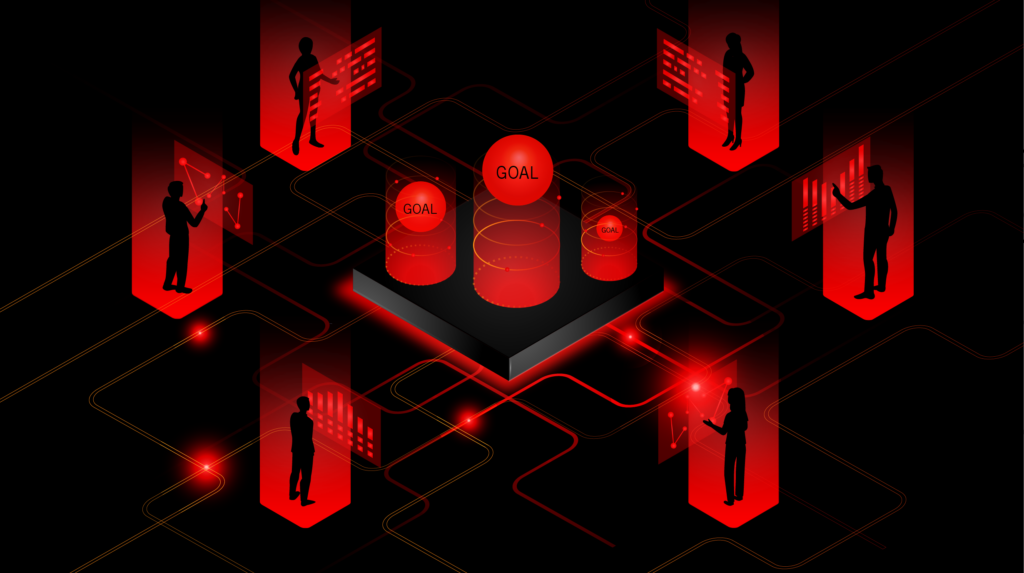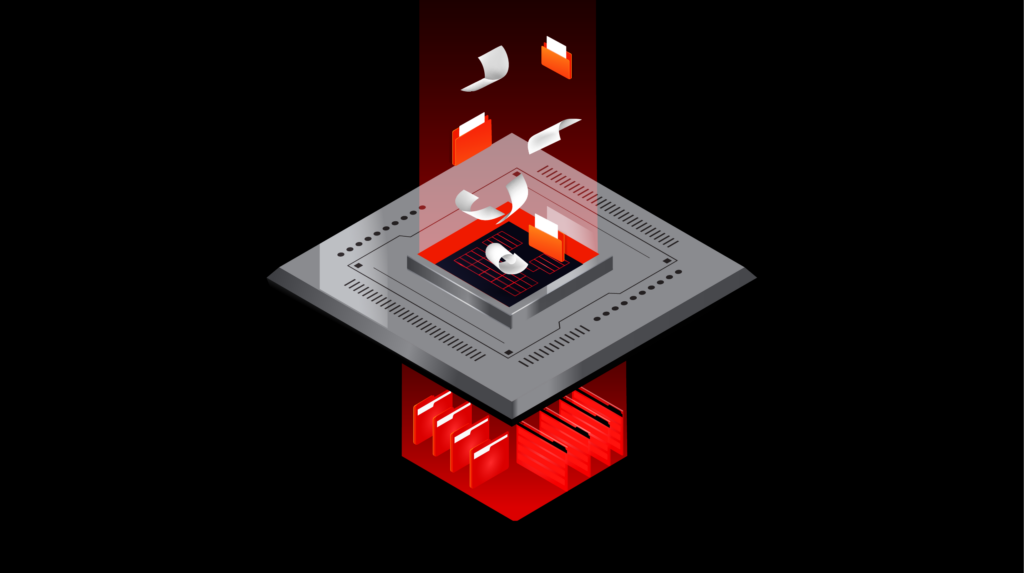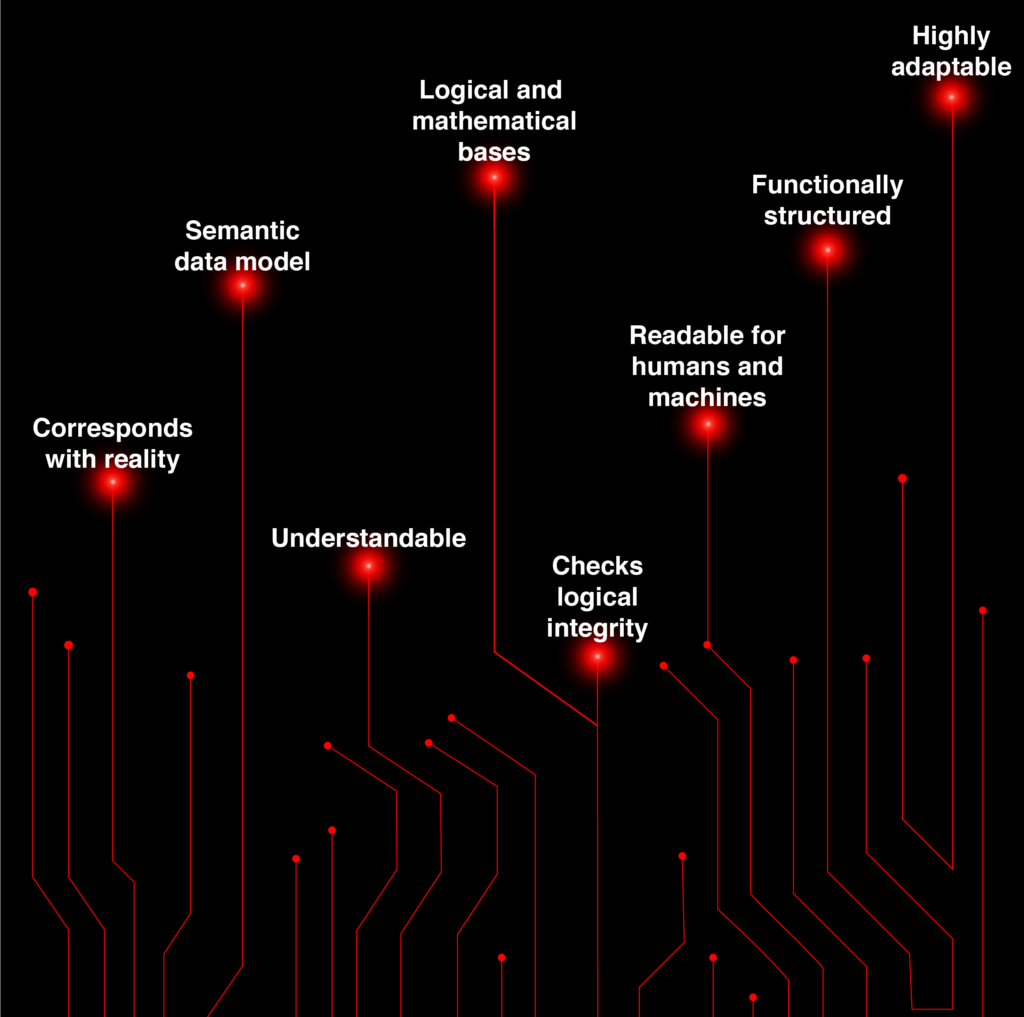Match™ Data Processor
THE NEW FRONTIER IN ARTIFICIAL INTELLIGENCE AND DATA SCIENCE
Why data processing needs
a paradigm shift?
Mastering data complexity is critical to the digital transformation of today’s business. To attain peak performance, organizations need to transform and exchange data across applications and humans. Because data transformations are inherently complex, well-defined knowledge and data models are essential for success.
From technology focus
Due to limited definitional capabilities of data formalisms, data often does not reflect reality. It is no exception that record-based information models, the current industry standard, do not correspond with reality. In data processing this gives rise to numerous data integrity violations and re-work. As data is a valuable company asset, this implementation approach has a negative impact on the cost-income ratio. Designing a model requires getting away from the technology focus and forward engineer back to reality. Only after a thorough understanding of reality, attention can and should be shifted to the lower-level data structures of data formalisms.
To understanding reality first
Defining a model requires a theory that helps to make sense of the intricacies of reality. Such a theory should deliver a body of principles to select attributes, reconstruct definitions and clarify data semantics prior to and independent of automation. To control data complexity, a modelling language that is aligned with a good theory, that is understandable for humans, easy to adapt and that doesn’t need further coding to be operational, is urgently needed. A model built through such a language, that is able to represent reality and to smoothly bridge the gap to automation, is called a 7th generation model!
Seamless data processing in practice

01
Business goal reconstruction
In multi-disciplinary teams, real business goals are reconstructed applying the theory of functional classifications. These goals guide the gathering and structuring of relevant data and knowledge. Using Match™ Developer, the goals are represented in a 7th generation model.

02
Data model and transformation definition
In collaboration with domain experts, a data universe is designed of source and target data together with a model of transformation knowledge. This results in a transparent and consistent single-point-of-truth 7th generation model.

03
7th generation data processing
The AI reasoning engine drives the Match™ Data Processor. It conducts data transformations without code. Changes are accommodated easily as the 7th generation models are written in business language and the integrity is automatically checked.

04
Seamless operations based on data and knowledge
The quality and flexibility of 7th generation data processing keep the new data source completely aligned to the business ambitions to serve clients and employees through relevant data and intelligence at the same time.
7th generation models
The theory of functional classifications takes AI and Data Science to the next level. It explains intrinsic characteristics of reality as equivalence and relativity and the theory delivers practical guiding principles to model data, definitions and processing logic. The Match™ AI & Data platform is aligned to this theory and built upon solid foundations of mathematical logic. The highly advanced cloud-based Match™ platform allows the business to design 7th generation models that are executable without code and capable of executing complex data transformations.

Showcase regulatory reporting
Data processing based on Match™ knowledge models is the new way of conducting digital transformations. We model the reality of complex business processes and have this model immediately available as an application. Knowledge Values already achieved improvements in key areas like risk and fraud detection, scalable and secure data migrations, anti-money laundering and regulatory reporting.

Regulatory reporting through 7th generation models
In the insurance industry, the Match™ Data Processor is applied to the annual reporting process of life insurance policies to the Tax Authority. Raw client data from different source systems is unified and transformed according to guidelines through 7th generation models ensuring compliance with the standards of the Tax Authority. Audit reports are composed per insurance policy and delivered automatically to the electronic archive. Through well-specified logic and robotised human knowledge, the workload of the reporting process decreased by 80% and maintenance costs dropped by 90%, while at the same time reporting errors were eliminated.
Outsourced Data Transformation
Knowledge Values takes full responsibility for your data transformation. Our service would be:
- Collaborative modelling with our consultants
- Data transformations upon request
Data Transformation as a service
Knowledge Values set up data transformation software services to be used by employees or clients. Our service would be:
- Collaborative modelling of data transformation knowledge
- Perform your own data transformations
In-house Data Transformation
Knowledge Values can develop a data transformation capability within your organisation. Our service would be:
- Knowledge modelling and data transformation training
- Collaborative modelling of data transformation knowledge
- Enable you to perform your own data transformations
Features
The Match™ Data Processor is flexible and can be used to suit whatever needs, whether it is GDPR, MiFID, or any other kind of data transformation. Data transformations through the Match™ Data Processor allow for compliance by design and complex system migrations as they are based on 7th generation models with well-structured enterprise logic and data.
Enhanced access control
Manage user access to application features and functionality through the latest secure authentication and authorisation protocols. The principle of least privilege and separation of duties within the organisation are arranged through roles and groups.
Web-based services (SaaS)
Match Data Processor (MDP) is built for the web and designed with REST web services. This makes the application easy to use, integrate and manage. MDP is browser-independent and can be delivered as a host service or deployed on-premise.
Database connections
Automatically transfer and load transformed and improved output data from the Match™ Data Processor to most databases via direct connections, service or intermediate file. Create new master data records which are complete and correct.
Processing statistics
Data about data processing jobs is recorded and presented back visually to users through graphs and tables allowing managers to have control over costs, users, and data processing success rate.
SFTP Connectivity
Transfer sensitive output data generated from Match Data Processor securely to other systems, businesses or organisations automatically.
Data analysis dashboards
Drill down and perform fine-grained data analysis to gain deep business insights about data, performance and processes through customisable graphs and charts.
Benefits you have never seen
- Annual returns of investment up to 300%
- Greater employee productivity
- Extreme process adaptability
- Cost-efficient integration or even replacement legacy systems
- Minimum Time to Market of regulation updates
- Compliant operations in minutes
- Zero defects through smart validation
- Easy application of new regulations
- Complete, clear, consistent and correct specifications
- Drastically shortened application development time
- Extremely adaptable application with low maintenance costs
Shortened application development time
Clear, complete and consistent specifications
Enhanced data quality and data integrity
Complete description rules and data universes
Improve customer satisfaction
Data protection compliance
Minimal maintenance costs
Minimum time-to-market
Make your business shine with a revolutionary paradigm and artificial intelligence technology
Knowledge Values has been solving the most complex business challenges for over 20 years. The core instrument is our scientific paradigm and accompanying AI & Data technologies that allow us to get the complexity of data and knowledge under control. The Match™ Data Processor is built upon scientific expertise by allowing explicit data and implicit human knowledge to be analysed, cleaned and transformed to reflect reality and enable a seamless realisation of business goals.
Semantic data modelling course
This course shows how to control the complexity of database systems by understanding reality and reflecting it through the semantics of data. It is designed for you to learn core data concepts, professionalize your data skills and to assure that the data universe is aligned with the business goals.
Course outline
1
Reality, data universes and Match™
reality and having the right technology in place
2
Constructing a database universe I
3
Constructing a database universe II
4
Business value of a data universe
